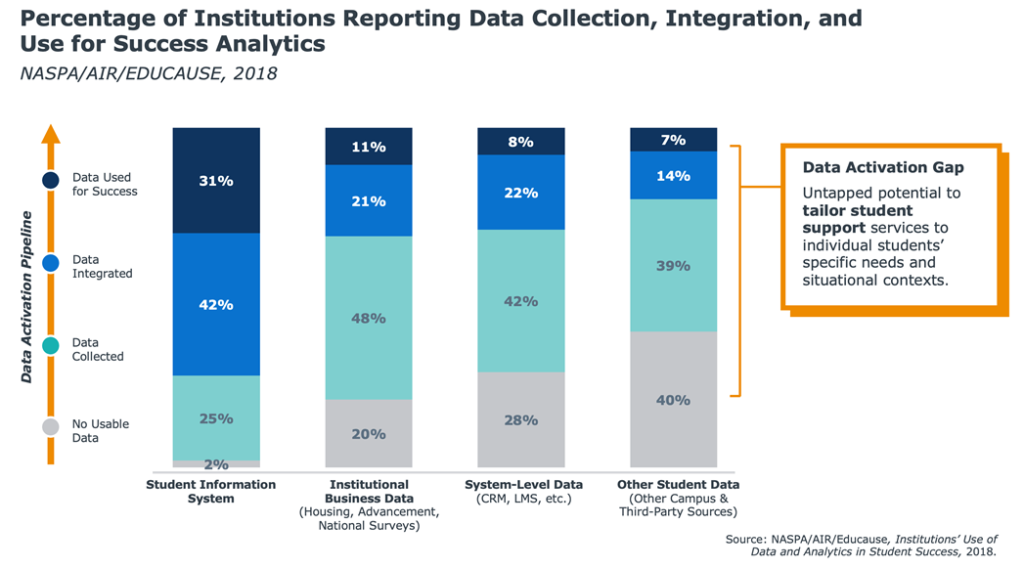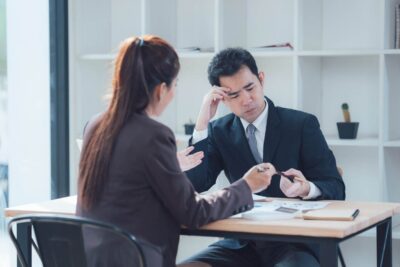4 new data opportunities for success analytics—and where you should begin
As the definition of “student success” becomes more nuanced and personalized, the growing volume of student data presents an opportunity for colleges and universities to deliver bespoke experiences and interventions for the right students, at the right time. But while decentralizing analytics—getting more data into the hands of staff and faculty who make decisions and drive impact—is a priority for most institutions, many remain limited by poor data accessibility.
Download the Data Priorities for Student Success Insight Paper
In 2018, a joint survey from the Association for Institutional Research (AIR), EDUCAUSE, and NASPA found that although many institutions are collecting more and more data about students in disparate systems, few were actually putting that data into action to support success analytics.

In August of 2021, EAB surveyed success leaders to see where the needle moved after 18 months of a global pandemic that has put student-centric innovation front and center. While we saw an uptick across segments, the same SIS-centric analytics environment persisted—with almost 97% of respondents using any of the listed systems for success analytics pulling personal, academic, and achievement data from the SIS.

Students increasingly expect their institutions to use the rich data that lives in every college and university silo to support them holistically, with personalized interventions and seamless in-person and digital services. To meet these expectations, student success efforts must look beyond traditional academic data to ensure that we understand every student in their own context and can support them to succeed. We’ve identified four areas of focus that the most progressive institutions are exploring.
A Note About Data Privacy
While students want personalized interventions, surveys suggest that they also care deeply about their data privacy—and it falls on institutions to manage this delicate balance. When turning to student data for success, your students’ own preferences should play a role in shaping campus strategy.
For most institutions, this means looking for ways to make data practices more transparent to students, faculty, and staff. The University of Michigan’s ViziBLUE initiative, for example, highlights the different data collected on students, and how it is used by the institution. They even provide a short video to explain how student data is collected and used.
4 opportunities for success analytics
1. Learning activity data
Can course activity provide early warning of student need?
As course modalities continue to evolve and students spend more time learning and interacting on digital platforms, identifying early indicators of student disengagement will be crucial to support mitigation and correction.
What learning activity data are progressive institutions using for success analytics?
According to our survey, just 33 of our 100 webinar participants reported using learning management system (LMS) data for student success. Of those respondents, more institutions reported using log-in records (67%), assignment submissions (55%) and quiz scores (45%) than discussion participation (36%) and syllabus interactions (9%).

2. Financial interactions
Which financial roadblocks are most disruptive to success?
Financial stressors are a leading factor in students’ stop-out decisions. Success teams that can identify relationships between money milestones and student attainment will open up new opportunities to inflect retention.
What financial interaction data are progressive institutions using for success analytics?
Among the financial data surveyed, 37 of our 100 participants noted some use for success—ahead of both learning activity and campus engagement. Financial aid awards (78%) and registration holds (73%) were the most widely used, with student billing (38%) and deposit dates (24%) lagging, and meal plan spending (5%) rarely in use at all.

How Data & Analytics Can Reshape Student Support: View the Webinar
3. Campus engagement data
How do belonging and engagement impact success?
With the ongoing digitization of various campus processes and functions, success leaders that tap into these new datasets will fain a fuller picture of students’ experiences—and where greater support can bolster belonging and success.
What campus engagement data are progressive institutions using for success analytics?
Outside of advising appointments (81%), which many EAB partners interrogate through their use of Navigate, few webinar registrants reported using campus engagement data in their success analytics. With just 36 of our 100 attendees recording the use of this type of data overall, the use of extracurricular activities (39%), event attendance (33%), card swipes (31%) and WiFi or facility use (17%) were some of the lowest-specified data in use for analytics.

4. Disaggregated demographics
How do success outcomes vary across student populations?
For every aspect of student success, gaining a more granular understanding of how different individuals and groups of students experience school is paramount for designing high-impact and targeted interventions.
What demographic data are progressive institutions using for success analytics?
While demographic data was by far the highest-reported data in use for success (with 61 of our 100 webinar attendees reporting some adoption), most institutions reported using classic demographic markers like race and ethnicity (89%), Pell Grant eligibility (89%) and first-generation status (84%). Far fewer reported using gender identity (57%) and age (48%), and marital or parent status (21%) was the least utilized.

Where should you start?
Across these various datasets, success leaders have a unique opportunity to harness campus data for analytics that matter—by focusing on uncovering insights to enable interventions and experiences that support and empower students directly. Yet the vast sea of data available across domains like learning activity, finance, engagement, and demographics often intersect, making it difficult to prioritize a manageable area of inquiry to get started. If you’re feeling overwhelmed, remember three core tenets of successful data projects:
- Define the value first.
The most impactful analytics start with a hypothesis linked to action steps that can be taken by the team doing the analyses. For success teams, that means focusing on developing new visibility to drive interventions and support structures to improve student outcomes. - Start small, then scale.
Too many data and analytics projects get mired in the complexities of campus politics, because their scope of data inquiry demands broad consensus building around things like common data definitions. The smaller the scope, the lower the burden of bureaucracy before value can be realized. - Build a coalition of the willing.
Related to the first two tenets, political barriers and data naysayers create additional headwinds for teams looking to fail fast and learn quickly with data. To improve the likelihood of a project moving to fruition, move forward with leaders and functions willing to take the leap, and return to more skeptical colleagues with tangible examples of value as the project matures.
More Blogs

EAB Wrapped 2025: A year of reckoning—and reinvention—in higher ed

Why space utilization reports may not be actionable enough for higher ed leaders
